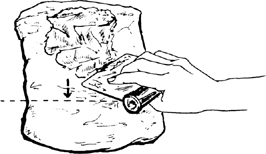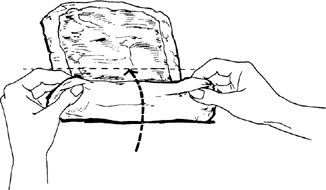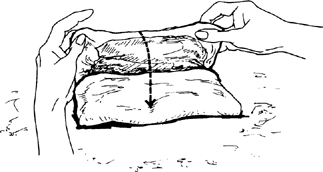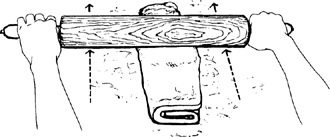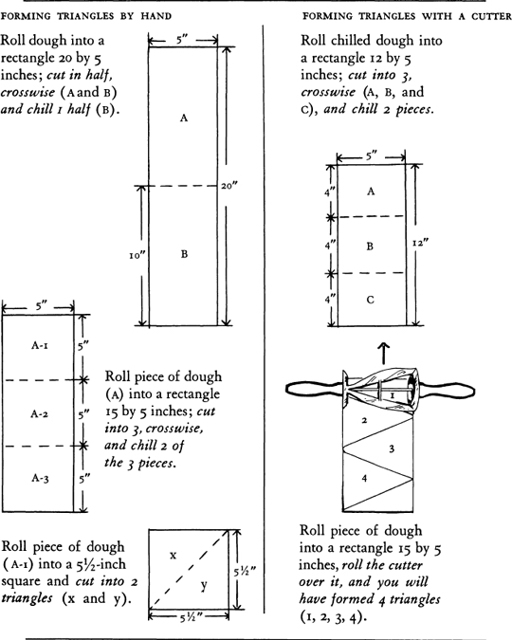Mastering the Art of French Cooking, Volume 2 (46 page)
Read Mastering the Art of French Cooking, Volume 2 Online
Authors: Julia Child

| Place chilled dough on a lightly floured pastry marble or board. |
Spread butter as evenly as possible over the upper two thirds of the dough rectangle, leaving a ¼-inch unbuttered border all around. |
|
| Dough is now to be folded into three layers, just as though you were folding a business letter. |
Fold the top |
|
| For Turn Number 2, lightly flour the top of the dough and your rolling surface, turn the dough so the edge of the top flap is to your right, as though it were a book you were going to open. |
Fold again in three. You now have 7 layers of dough separated by 6 layers of butter; at the end of the fourth roll there will be 55 layers of dough.
Sprinkle dough lightly with flour, wrap in waxed paper or plastic, place in a plastic bag and refrigerate. Dough must now rest for 1 to 1½ hours to deactivate the gluten so that you can make the two final rolls without difficulty.
4)
Turns 3 and 4
—
after a rest of 1½
to 2 hours in the refrigerator
Unwrap dough, sprinkle lightly with flour, and deflate by tapping lightly several times with rolling pin. Cover and let rest for 8 to 10 minutes, again to relax gluten. Being sure that the top and bottom of dough are always lightly floured, start rolling dough into a rectangle 14 by 6 inches. If you notice that butter has congealed into hard flakes, beat dough with light firm taps for a minute or so, going from one side to the other until butter has softened: it must be able to extend the length and width of the rectangle inside the dough as you roll it out. Fold rectangle in three, roll again into a rectangle, and fold in three to complete the final turn. Wrap and chill for 2 hours before
forming dough into croissants, or leave overnight covered with a board and a 5-lb. weight.
5)
Forming croissants
—
after dough has rested 2 hours in refrigerator
The dough is now ready to be rolled out into the usual rectangle and then cut into triangles that are rolled up and twisted into crescent shapes. Professionals use
either the ingenious triangle-cutting roller illustrated, or do all the cutting by hand. To make everything as easy as possible for yourself, refrigerate all pieces of dough you are not actually working on.
PRELIMINARIES
A large sheet of plastic
A large, lightly buttered baking sheet (14 by 16 inches at least)
Unwrap chilled dough, place on a lightly floured surface, and deflate by tapping several times gently with rolling pin. Cover with plastic and let rest 10 minutes, to relax gluten.


